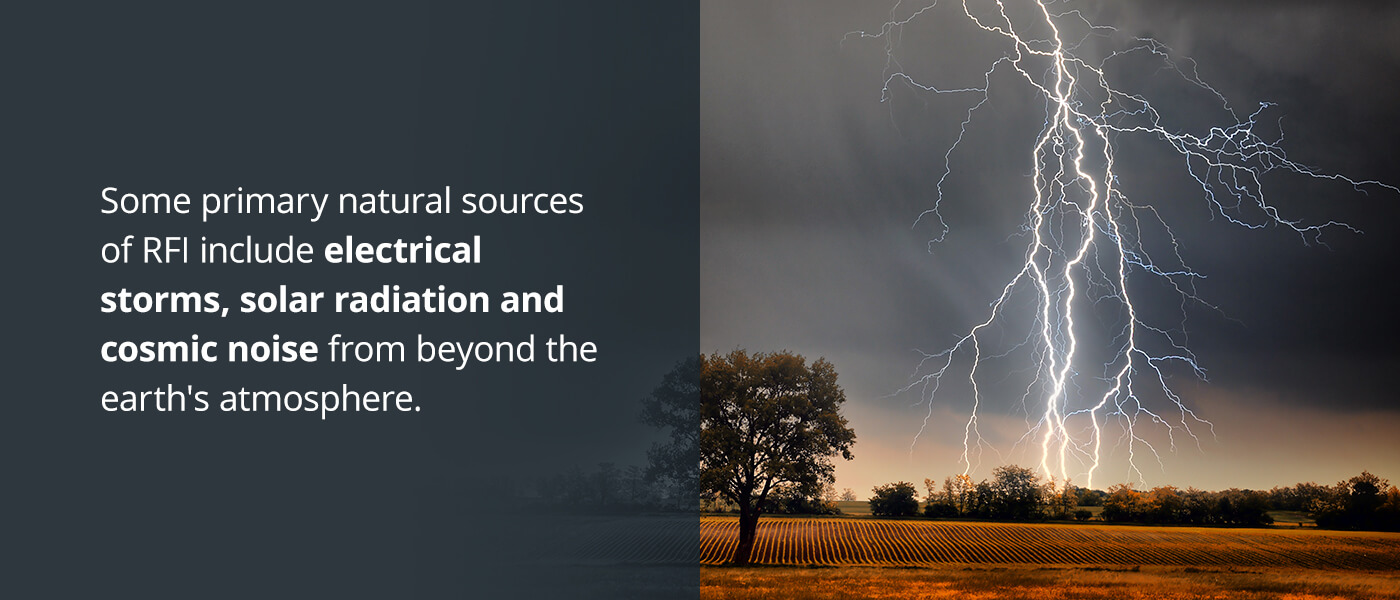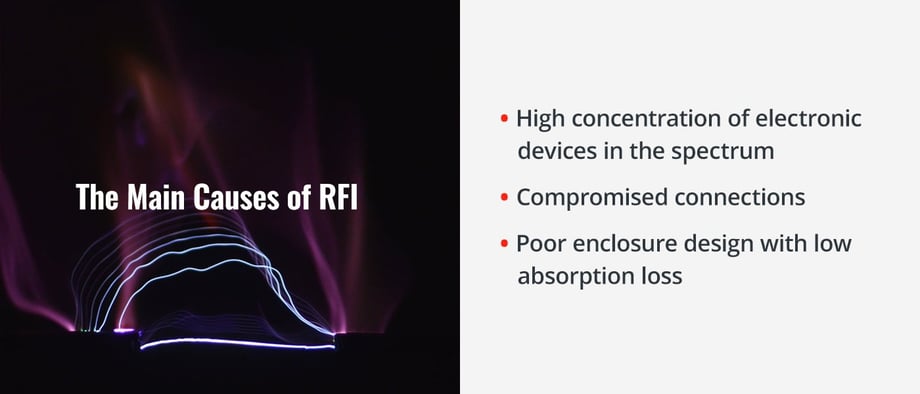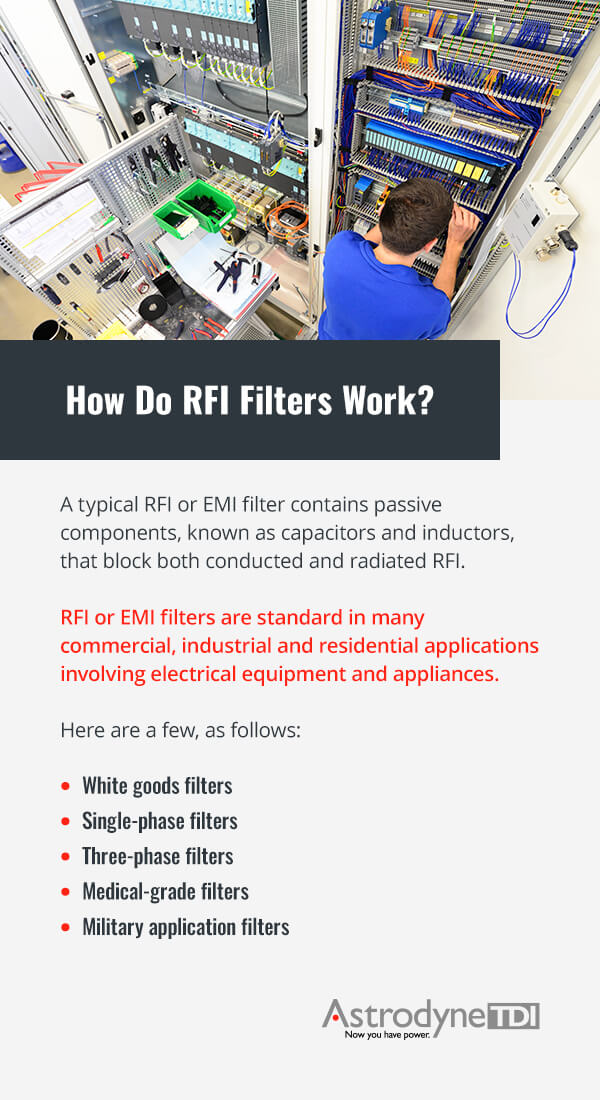RESOURCES
RFI Filter Basics
If your business involves electronics or electrical equipment, you probably contend with radio frequency interference (RFI). As a result, you need reliable ways to reduce RFI and prevent the electrical performance interference and damage it can cause. Where do you begin? When you're strategizing about how to reduce electromagnetic interference, filters offer a convenient, reliable solution. However, you may not know exactly what they can do for your equipment and operations. That's why we've created this guide — to explain the basics of electromagnetic interference, discuss common causes and sources of RFI and elaborate on how RFI or EMI filters work and how they can help.

What Is Radio Frequency Interference?
Radiofrequency interference is a specific subset of electromagnetic interference (EMI) that includes electromagnetic currents between 3 kilohertz and 300 gigahertz. It occurs when electronic devices become exposed to external electromagnetic fields and unwanted radio frequency signals that disrupt their operation. It also happens when electronic devices generate unwanted radio frequency signals that can potentially interfere with the semiconductor devices found in other electrical equipment. RFI is a widespread phenomenon, both in industrial applications and in everyday life.
RFI may stem from either natural or human-made sources. Some primary natural sources of RFI include electrical storms, solar radiation, and cosmic noise from beyond the earth's atmosphere. Common human-made sources of RFI include equipment and devices like radios, TVs, computers, and power lines..jpg?width=748&name=MRIDC%20(2).jpg)
Fig. 1 - The electromagnetic spectrum showing frequency from DC to 300 GHz and common EMF sources.
Examples of Electromagnetic Interference
What are some examples of electromagnetic interference? In everyday life, RFI might disrupt the use of a radio, TV, phone, or garage door opener. The RFI from a large power station might interfere with the use of a phone or computer. Someone running a hairdryer or vacuum cleaner in a home may interfere with the operation of the TV, or a fierce lightning storm might cause sudden static on radio stations. In industrial use, a large piece of equipment like a power supply might generate electromagnetic interference and send it through the power system, potentially disrupting the operation of other equipment on the same network.
Those who fly frequently know that turning off their phones is a part of the process. The reason airlines ask passengers to shut down their mobile electronic devices during takeoff and landing also involves RFI. The Federal Aviation Administration has been concerned that mobile devices could produce enough RFI to disrupt a plane's electronics, including avionics and GPS systems, leading to safety issues.
RFI is sometimes harmful to electronic equipment and equipment components. It can cause parts to degrade and may eventually lead to catastrophic equipment failure. Additionally, it increases expenses by necessitating costly repairs and can lead to equipment downtime, data losses, and electrical disasters.
Generally, RFI can arise in several different ways. In interconnected wiring inside the equipment, RFI sometimes occurs in response to impedance opposition due to the current or voltage variances within conductors. Externally, RFI may come from solar flares, telephone or power lines, and other electrical equipment or power cords.
Conducted vs. Radiated RFI
RFI can take many different forms, depending on whether the radiation is direct or indirect.
- Conducted RFI: Conducted RFI is direct RFI. It occurs when the source transfers electromagnetic emissions to a receiver, such as another piece of equipment, along a direct physical route like a power cord. RFI that occurs along power lines or electrical cabling, for instance, is conducted RFI. Conducted RFI frequently occurs in electrical motors, DC/DC converters, switch-mode power supplies, microcontrollers, and thermostatically controlled appliances.
- Radiated RFI: Radiated RFI is indirect RFI. It travels through the air instead of passing on through physical contact. It most often occurs when electronic devices either intentionally or unintentionally produce an electrical field of electromagnetic energy. The radiation can expand outward over long distances, interfering with the electronic devices and equipment in its path. Almost all electronic devices produce some level of radiated RFI.
.jpg?width=731&name=MRIDC%20(3).jpg) Fig. 2 – Diagram visualization of radiated RFI vs. conducted RFI between a transmitter and receiver.
Fig. 2 – Diagram visualization of radiated RFI vs. conducted RFI between a transmitter and receiver.Narrowband vs. Broadband Emissions
RFI also breaks down into two additional categories — narrowband emissions and broadband emissions.
- Narrowband emissions: These RFI emissions usually stem from human activities and occur on a very narrow portion of the radio spectrum. The buzz you sometimes hear along power lines is a good example of narrowband RFI emissions.
- Broadband emissions: These RFI emissions may come from either human-made or natural sources, occurring over a much more extensive range of the electromagnetic spectrum. They can happen in response to one-time events, like lightning strikes, or ongoing events, such as the operation of a power supply or piece of machinery.

The Main Causes of RFI
What are typical sources of electromagnetic interference within a piece of electronic equipment? Before you understand how to prevent EMI, you should know more about the causes of RFI so you're prepared with the correct solutions. Below are a few of the most common causes of RFI in electronic equipment:
- High concentration of electronic devices in the spectrum: RFI often occurs when too many electronic devices operate over the radio frequency (RF) portion of the electromagnetic spectrum. The radio spectrum contains frequencies between 30 hertz to 300 gigahertz. Because so many devices, technologies and services operate over this relatively narrow spectrum, they frequently interfere with one another.
- Compromised connections: Frequently, RFI occurs because of poor connections within electronic devices. Poor connections cause arcing, a phenomenon that occurs when an electrical current jumps a gap in a circuit or between two electrodes. When that jump happens, the arced current is very hot, often causing fires and producing RFI. RFI from arcing happens in switches, relays, silicon-controlled rectifiers (SCRs), motors, and loose connections. RFI in industrial environments also commonly transpires in electrically noisy circuits, such as those found in standard power supplies and uninterruptable power supplies (UPSs).
- Poor enclosure design with low absorption loss: In other instances, RFI may happen because of enclosure design flaws. A piece of electrical equipment may have an enclosure or shield designed to reduce the RFI that escapes into the environment. An enclosure that functions effectively causes high absorption loss, known as the dissipation of electromagnetic energy. An enclosure that functions ineffectively causes low absorption loss, allowing electromagnetic energy to escape instead of dissipating.
Identifying RFI Sources
When you're working with power supplies and other electrical equipment susceptible to RFI, you need dependable ways to identify the source of the RFI in your operations so you can control and mitigate its effects. To do so, you'll need to know where to look. Check these common sources of RFI to see where the interference may begin:
- Fundamental receiver overload: This type of RFI occurs when a powerful transmitter overwhelms a nearby receiver.
- Power line noise: Power line noise generally occurs when arcing develops on nearby utility lines. It can cause an audible harsh buzz and noticeable interference in nearby electronics and radio signals.
- Switch-mode power supplies: When your industrial equipment relies on power supplies, this type of RFI is relatively standard. Switch-mode power supply RFI occurs when the circuits within the power supply give off unwanted electrical signals that interfere with other equipment or devices.
If you need to locate the specific source of RFI, you can try a few different options. One is to pan a directional antenna around the location and scan for the interfering signal. Another is to use radio direction-finding (RDFing) equipment to locate the source of the interference. These devices usually come in mobile, fixed, and portable options for your convenience. You can also use a step attenuator, which gives you a higher degree of control over the signal strength indicator as you near the RFI source.
Controlling and Minimizing RFI
No matter the cause of the interference, electrical equipment requires effective solutions for controlling and reducing EMI and its harmful effects. Let's discuss some of the strategies on how to prevent EMI so you're prepared correctly for your situation. Controlling and minimizing RFI depends on two primary factors. Your facility will likely need to use some combination of these techniques to reduce RFI effectively:
- Shielding: Shielding protects against radiated RFI. Shielding in electronic equipment generally consists of using a guard structure to protect vital circuit boards or prevent RFI emissions from escaping. The possibilities for guard structures and materials are extensive — common options include metal boxes, metal films, and conductive foam. On your cables, you might use heavy-gauge foil and drain wire shields or braided copper shields.
- Filtering: This aspect of controlling and minimizing RFI is Astrodyne TDI's specialty. Filters protect against conducted RFI, and they often pair with shields that protect against radiated RFI for a more comprehensive solution. They're ideal for controlling and minimizing RFI because they can protect your equipment from emitting RFI into the power supply or damaging its own sensitive components.

How Does an RFI Filter Work?
How do RFI or EMI filters work to protect against radio frequency interference? An RFI filter's design enables it to reject specific frequencies or types of interference within a power line or signal. A typical RFI or EMI filter contains passive components, known as capacitors and inductors, that block both conducted and radiated RFI.
RFI or EMI filters are standard in many commercial, industrial, and residential applications involving electrical equipment and appliances. Here are a few, as follows:
- White goods filters: White goods EMI filters reduce RFI from numerous home appliances like blenders, laundry machines, and dishwashers. They ensure compliance with electromagnetic compatibility regulations and protect against RFI damage.
- Single-phase filters: Single-phase EMI filters are most suitable for smaller pieces of electronic equipment like personal electronics, treadmills, food-service equipment, and telecommunications equipment that generate more modest amounts of RFI.
- Three-phase filters: The design of three-phase EMI filters enables them to handle the more substantial RFI from larger equipment such as motors, industrial machinery, and some medical equipment.
- Medical-grade filters: Advanced medical-grade EMI filters are ideal for sensitive medical equipment and meet specific requirements for medical applications. For instance, MRI room EMI filters protect the MRI machine from interference from lightning, power lines, or other hospital equipment, so they are indispensable for creating a safe, secure environment for medical imaging.
- Military application filters: Sophisticated military application EMI filters protect against interference and damage in aerospace and military communications applications. They meet all the applicable regulations and compliance standards for military devices.
4 Common Types of RFI Filters
When choosing RFI or EMI filters, you'll need the ones that will best disperse reduce interference for your specific equipment, operations, and type of RFI. Let's discuss four of the most common types of RFI filters and how they work:
- Low-pass: Low-pass filters enable lower frequencies of electromagnetic noise to pass through while impeding higher frequencies. In other words, they attenuate high-frequency signals. Most power supplies and other types of electronic equipment operate at relatively low frequencies, while EMI tends to come in at higher frequencies. Low-pass filters are ideal for allowing the low-frequency power signals to pass through the current while blocking the higher-frequency electromagnetic interference.
- High-pass: High-pass filters enable higher frequencies of electromagnetic noise to pass through while impeding lower frequencies. They attenuate lower-frequency signals.
- Band-pass: Band-pass filters allow signals within a specified frequency range to pass through the circuit while impeding all others. They might pass several mid-range frequencies while hampering higher- and lower-frequency signals. They attenuate all frequency signals except those their design specifically permits.
- Band-stop/band-reject: Band-stop or band-reject filters, on the other hand, admit all signals except those within a specified frequency range, to which they provide strong impedance. They attenuate only the signals within that specific frequency range.
Dependable RFI Filters From Astrodyne TDI
When you need reliable RFI or EMI filters for your company's equipment, partner with Astrodyne TDI for trusted solutions. We have more than 60 years of experience in researching, developing, and supplying high-quality EMI filters for a range of industry applications, and we're happy to consult with you to make sure you get the filters that work best for your unique electrical needs.
When you work with us, you get quality filters that dependably reduce electromagnetic interference. We back our EMI filters with a one-year warranty, and we're always here to assist you with technical support and part replacement when you have questions or need to upgrade your equipment. Then, you'll have reliable access to the right solutions for EMI — all with help from experts along the way.
Request a quote from us today or contact us to purchase RFI filters that protect against unwanted electromagnetic interference in your operations.



